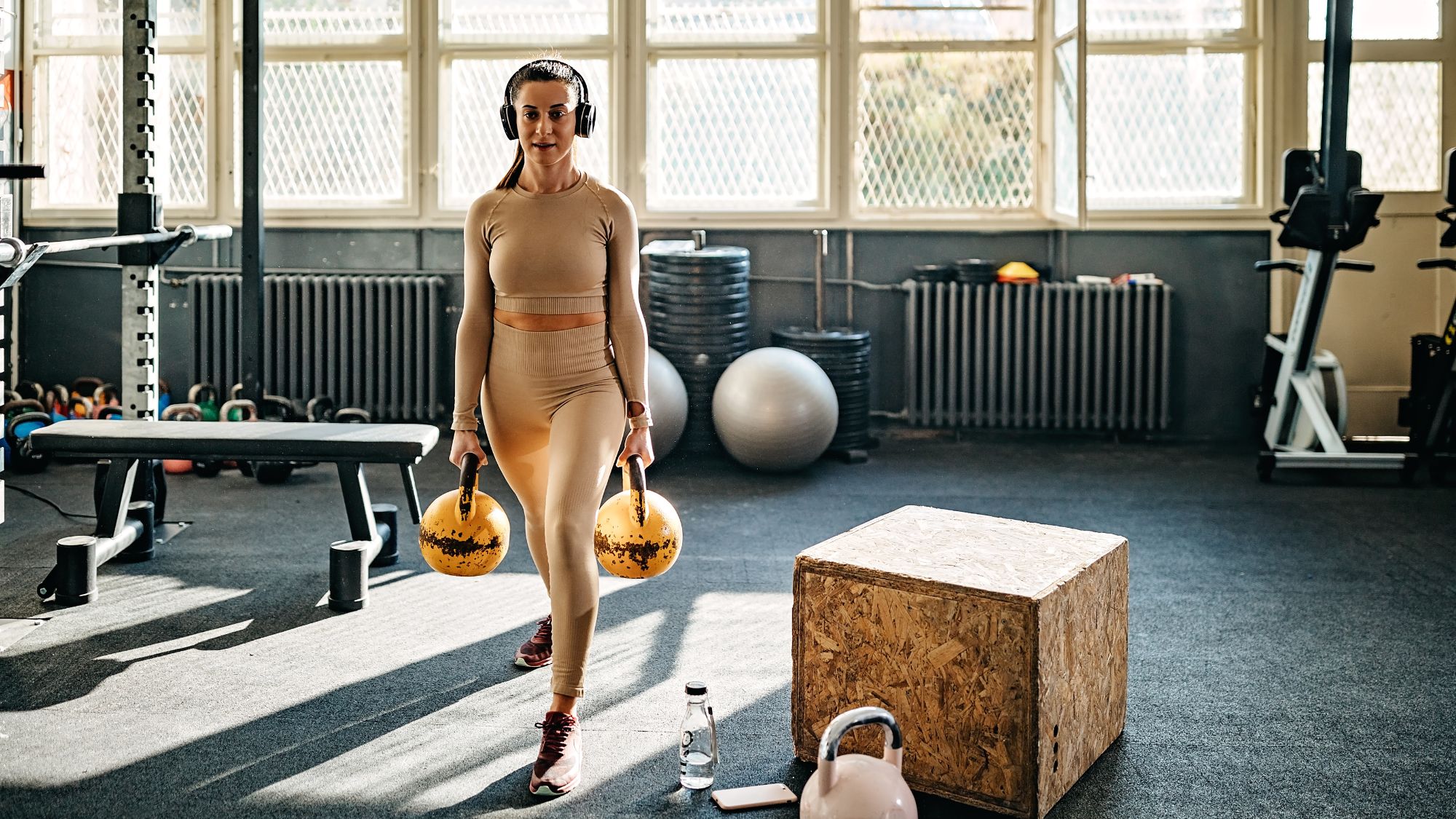Kettlebell exercises are one of the easiest ways to boost your fitness - 9 moves to do from home or the gym
Jennifer Aniston, Lizzo, and Penelope Cruz all strength train with the piece of kit.


You'll have heard of kettlebells - a simple piece of gym equipment designed for strength training at the gym or from home.
During the pandemic, they were one of the many hotly-in-demand pieces of exercise equipment. If your kettlebell has been gathering dust ever since or you simply need some ideas of how best to utilise it, know this: they're a handy addition to any workout.
Why? Well, one study published in the Strength and Conditioning journal found that kettlebell workouts can help build a healthier lower back, thanks to the loading and movement patterns you use when working out with one. Plus, they boost full body strength, improve coordination and mobility, and improve grip strength.
“A kettlebell is a versatile piece of equipment,” explains Rachael Penrose, personal trainer and fitness instructor at F45 Paddington. Recognisable by its unique shape (a round base and curved handle on top to grip onto), a kettlebell exercise is any movement using this piece of equipment.
Some common weight lifting exercises using the piece of kit include kettlebell swings, deadlifts using kettlebells and the kettlebell clean and press, shares Penrose.
For her go-to's, keep scrolling. Don't miss our guides to home workouts, weight lifting apps, and gym workouts, while you're here.
Kettlebell exercises: your guide
Great for building muscle, strengthening and toning, Penrose is a fan of the kettlebell. “I personally like to use kettlebells with my clients for movements like a goblet squat, kettlebell clean and press and my favourite mobility move, the Turkish get up," she shares.
Celebrity news, beauty, fashion advice, and fascinating features, delivered straight to your inbox!
The joy of a kettlebell is that it can be incorporated into practically any move, she adds. For example, it can be used as an added weight or to challenge balance. The kettlebell’s handle is also easy to grip so it works well in swings and is easier to manoeuvre than a dumbbell, says Penrose.
Beginners should stick to simpler moves, such as squats, lunges, the chest press and the farmer’s carry while getting used to doing them with the weight of a kettlebell, advises Penrose.
Try this: For a simple ten-minute kettlebell workout, she recommends selecting five of the below moves and performing one set of each for 45 seconds (rest for 15 seconds and then repeat a second lap).
Kettlebell exercises: 9 to try tonight
“When looking at a workout, I focus on the seven functional ways we are designed to move: These are squat, lunge, hinge, pull, push and gait,” explains Penrose. “With this in mind, I would plan to cover all these movements, with the added challenge of incorporating a kettlebell for a full workout.”
Try Penrose’s go-to kettlebell exercises below, complete with handy tips on how to nail each of the moves. From kettlebell exercises for the chest and abs to those that’ll work your back and glutes, this useful kettlebell workout is one to bookmark.
Want a few more free sessions to bookmark? Our PT approved glute workout, lower body dumbbell workout (simply switch out the weights for kettlebells) and full body workout are also ones to try.
1. Kettlebell squats
This is an ideal kettlebell exercise for the legs, shares Penrose, as it targets a wide range of muscle groups.
How to: Flip the kettle upside down and hold it in a goblet position in front of your chest while squatting.
How long? Aim for 45 seconds.
2. Weighted lunge
A weighted lunge is one of the easiest weight training moves to perfect - follow the instructions below to if you've never tried before.
How to? There’s an option here to hold a single kettlebell in a goblet position. Alternatively, hold two kettlebells by your side while performing alternating lunges, recommends Penrose.
How long? Aim for 45 seconds.
3. Romanian deadlifts
The Romanian deadlift is the perfect hinging motion, according to the trainer.
How to: Begin with your feet hip width apart and hinge forwards. Keeping your abs and back engaged, grip the kettlebells and pull your shoulders back. Tightening your leg muscles, pus through your feet until you are standing and holding the kettlebells on either side of your body. Engage your glutes.
How long: Aim for 45 seconds.
4. Kettlebell swings
A kettlebell swing is an explosive movement. Do note: the PT advises that you should only be done once you have mastered an RDL (that's a Romanian Deadlift, FYI).
How to: Again, standing with your feet at hip width apart, hold the weight in front of your body with both hands. Bending your knees, swing the kettlebell through your legs until it reaches shoulder height. Being careful not to lock out your elbows, return and repeat.
How long: Aim for 45 seconds.
5. Bent over row
Keen to improve your arm or back strength? This is a great kettlebell exercise for just that.
How to: In a bent-over position holding a single or set of kettlebells, pull them towards your hip while engaging through your back.
How long: Aim for 45 seconds.
6. Overhead push
This is great for improving your ab strength - just be careful to maintain good form when lifting the weights overhead.
How to: Standing in an upright position, drive the kettlebell from your shoulder upwards and then control the descent.
How long: Aim for 45 seconds.
7. Weighted Russian twist
This is one of the best rotational core exercises going, according to the PT.
How to: Attempt to lift your feet off the ground as you rotate through your torso, tapping the kettlebell from side to side with control.
How long: Aim for 45 seconds.
8. Farmer’s carry
While it may look like an easy exercise, a farmer’s carry is not for the faint-hearted, shares Penrose.
How to: Carrying a set of kettlebells, walk forward and back, or round in a circle, while being extremely conscious of your alignment from your head all the way down to your feet. Keep your core engaged. It will also work on your grip strength.
How long: Aim for 45 seconds.
9. Turkish get up
“The mobility move to end all mobility moves," shares Penrose. The Turkish get-up requires strength, coordination, extreme control and works quite literally every muscle in the body. This is an advanced move and will take some time to master, he adds.
How to: Starting on your back in a starfish position, bend one of your legs and, holding the kettlebell in the hand on the same side, raise your arm, whilst holding the weight, straight up towards the ceiling. Keep your eyes on the weight and be careful not to bend your elbow.
How long: Aim for 45 seconds.
Do kettlebell workouts really work?
Short answer: yes. As PT Penrose explains, they're a simple yet effective way of building muscle, strengthening and toning.
Kettlebells are pretty versatile, too - they can be used in most workouts, so you needn't be intimidated if you've never used one before.
If you're new to kettlebell workouts, she recommends trying a session with squats and lunges, to begin with.
Amy Sedghi is a freelance journalist, specialising in health and fitness, travel, beauty, sustainability and cycling.
Having started her career in The Guardian newsroom working with an award-winning team, Amy's proud to have reported on a variety of topics, speaking to a range of voices and travelling far and wide to do so. From interviews on ski lifts to writing up breaking stories outside courtrooms, Amy is used to reporting from a range of locations (she’s even been known to type up a story in a tent).
She also loves being active, spending time outdoors and travelling - with some of her favourite features she’s worked on combining all three. Cycling and eating her way round the Isle of Man, learning to sail on the Côte d'Azur and traversing the Caminito del Rey path in Spain are just some of her highlights.
Covering a diverse range of subjects appeals to Amy. One minute she may be writing about her online styling session with Katie Holmes’ stylist and the next she’s transporting readers to the basketball courts of Haringey where she joined a group trying to lower knife crime in the capital.
While at university, Amy was awarded The Media Society bursary. Following her stint at the Guardian, Amy worked at Google and as well as writing for Marie Claire, she regularly contributes interviews, features and articles to National Geographic Traveller, The Guardian, The Independent, The Telegraph, Stylist, Refinery29, Glorious Sport, Cycling Weekly and Rouleur.
When she’s not writing, Amy can be found trying to get through her towering stack of books-to-read, cycling down at Herne Hill Velodrome or looking for the next place to eat and drink with friends.
